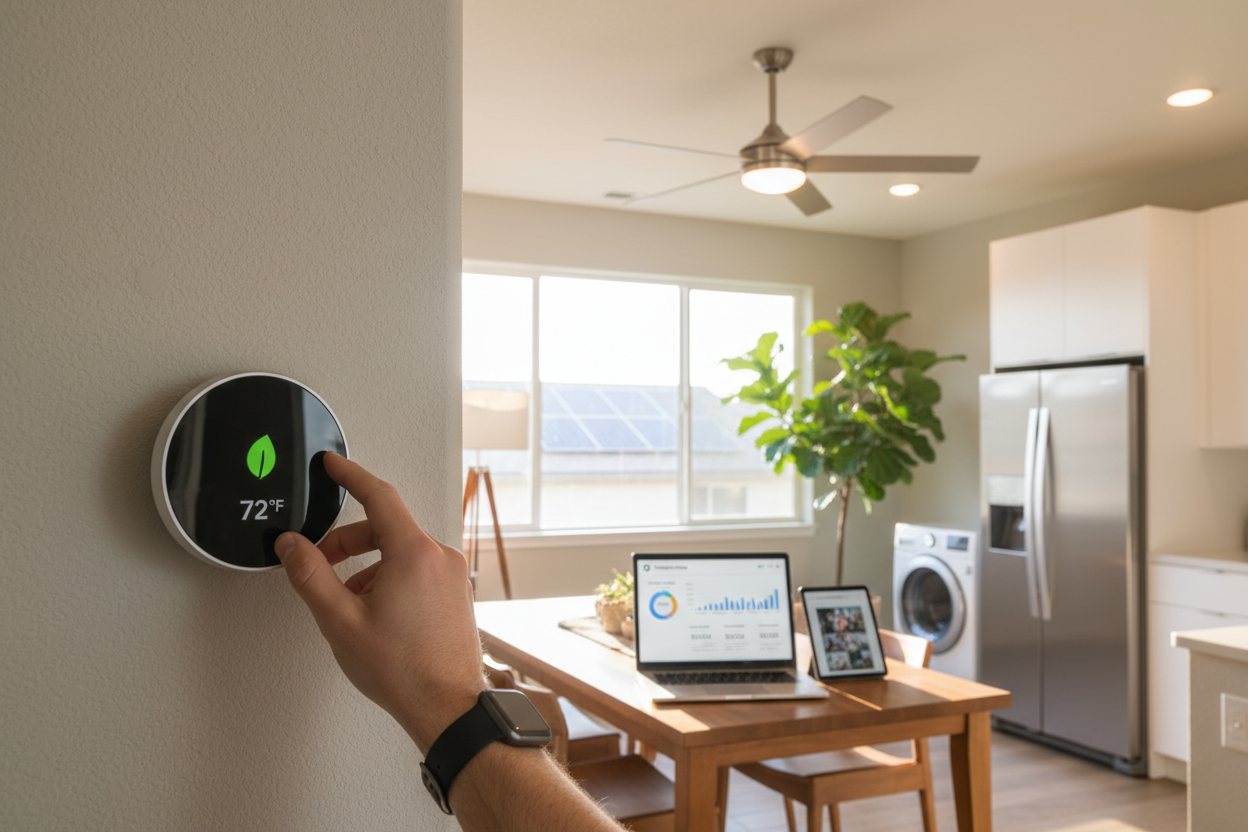Taking control of your home electricity plan and daily energy use can slash your bills and reduce environmental impact. From choosing the right plan to optimizing appliance use, this guide offers practical strategies to manage costs without sacrificing comfort.
Key Takeaways
- Choosing the right electricity plan, such as fixed-rate or prepaid, can simplify budgeting and increase control.
- Energy-efficient appliance use, including cold wash cycles and proper refrigerator settings, reduces consumption significantly.
- Time-of-Use (TOU) rates and smart meters offer opportunities to save by shifting usage to off-peak hours.
- Efficient electric vehicle charging and home appliance protection plans provide long-term savings and peace of mind.
- Small upgrades like insulation, HVAC maintenance, and home energy audits maximize efficiency and unlock rebates.
Table of Contents
- 1. Understanding Your Electricity Plans for Home Savings
- 2. Energy-Efficient Appliance Use: Cut Costs Smartly
- 3. Time-of-Use Rates and Smart Meter Benefits
- 4. Electric Vehicle Charging and Energy Savings
- 5. Home Appliance Protection Plans: Safeguard Your Budget
- 6. Additional Tips for Energy Efficiency at Home
- 7. Resources for Managing Energy Use and Staying Informed
- Conclusion: Take Charge of Your Electricity and Save
- FAQ
1. Understanding Your Electricity Plans for Home Savings
Choosing the right electricity plan is foundational for controlling your monthly costs. Utilities often offer a variety of plans that cater to different needs—from fixed-rate electricity plans to prepaid plans.
Fixed-Rate Electricity Plans: Predictability and Peace of Mind
These plans lock in a set price per kilowatt-hour for the term of your contract, protecting you from market fluctuations. They are ideal for smaller households or those preferring budgeting stability.
- Locked-in prices for predictable billing
- Flexible contract lengths, often 1–2 months
- Extra incentives like bill credits and free electricity on high-usage days
- Discounts for autopay and digital billing
For example, some providers like Reliant offer up to $200 in bill credits for new customers.
How Electricity Bills Are Structured
Understanding your bill breakdown helps manage costs:
- Generation Charges: Costs to generate electricity.
- Delivery Fees: Fees from Transmission Distribution Service Providers (TDSPs) delivering power to your home.
Delivery fees vary by region, making it important to be conscious of when and how you use energy. Learn more about pricing in Texas.
Prepaid Electricity Plans: Flexibility and Control
Prepaid plans allow you to pay upfront and monitor your consumption in real-time. These provide excellent control and are suitable for budget-conscious consumers.
- Track usage through apps or online portals
- Receive alerts to adjust consumption quickly
- Avoid surprise bills
2. Energy-Efficient Appliance Use: Cut Costs Smartly
Appliances contribute heavily to home energy use. Small changes and upgrades can make a difference.
Washer and Dryer Tips for Energy Conservation
- Use cold wash cycles when possible.
- Run full loads rather than multiple small wash cycles.
- Line-dry clothes to reduce dryer use.
- Consider upgrading to ENERGY STAR certified washers and dryers.
Refrigerator and Freezer Settings for Savings
- Maintain fridge temperature between 35°F and 38°F (1.6–3.3°C).
- Freezer temperature should be close to 0°F (-18°C).
- Regularly check door seals and clean condenser coils.
- Avoid overpacking to allow proper air circulation.
More tips from the U.S. Department of Energy.
Managing Stove, Oven, and Dishwasher Usage
- Use microwaves or toaster ovens for smaller meals instead of heating a full oven.
- Match pot sizes to burners to avoid wasted heat.
- Run dishwashers only when full and use eco or energy-saving modes.
- Let dishes air dry to save energy on heated drying.
See more kitchen efficiency advice from ENERGY STAR.
Efficient Water Heater Settings and Maintenance
- Set water heater thermostat to about 120°F (49°C).
- Insulate the water heater and hot water pipes.
- Consider high-efficiency models like heat pump water heaters.
- Flush sediment annually to keep systems efficient.
Guidance available from ENERGY STAR.
3. Time-of-Use Rates and Smart Meter Benefits
Time-of-Use (TOU) rates adjust electricity pricing based on demand, rewarding usage during off-peak times.
How TOU Rates Can Reduce Energy Bills
- Use high-energy appliances like laundry machines during evenings or nights.
- Charge electric vehicles during off-peak hours.
- Support grid balance and promote cleaner energy by lowering peak demand.
Smart Meters: Your Energy Insight Tool
- Track hourly and daily energy consumption.
- Detect unusual usage spikes early.
- Receive real-time pricing and outage alerts.
- Ease participation in TOU and other dynamic pricing plans.
Learn more from the Department of Energy.
4. Electric Vehicle Charging and Energy Savings
Efficient EV charging at home reduces electricity costs and helps the grid.
- Use smart chargers to schedule charging for TOU off-peak hours.
- Benefit from rebates or tax incentives for Level 2 charger installations.
- Combine EV charging with home solar arrays to maximize sustainability and savings.
See tips from EcoFlow.
5. Home Appliance Protection Plans: Safeguard Your Budget
Unexpected appliance repairs can be costly. Appliance protection plans help shield your finances.
- Coverage for refrigerators, ovens, laundry, HVAC, and plumbing.
- Scheduled maintenance extends appliance lifespan and efficiency.
- Save up to 35% with seasonal discounts on plans.
- Gain financial peace of mind and avoid surprise repair expenses.
Check options like WorryFree protection plans.
6. Additional Tips for Energy Efficiency at Home
Home Insulation and Air Sealing
- Add insulation in attics, walls, and crawlspaces.
- Seal leaks around windows, doors, and baseboards.
- Consider upgrading to double- or triple-pane windows.
Tips from PSD Consulting.
Heating, Ventilation, and Air Conditioning (HVAC) Efficiency
- Schedule annual professional tune-ups before peak seasons.
- Use programmable or smart thermostats to avoid heating/cooling unused rooms.
- Opt for ENERGY STAR certified high-efficiency units.
More on HVAC efficiency at ENERGY STAR.
Professional Home Energy Audits and Incentives
- Many utilities offer free or low-cost home energy audits.
- Audits reveal hidden inefficiencies to target for upgrades.
- Rebates and tax credits may be available via the Inflation Reduction Act or ENERGY STAR Home Upgrade programs.
Explore programs from Eversource.
7. Resources for Managing Energy Use and Staying Informed
- Real-Time Outage Maps: Stay updated on current outages and restoration timelines.
- 24/7 Customer Support: Access help anytime for billing or technical questions.
- Online Dashboards and Billing Tools: Monitor consumption, pay bills, and set budget alerts.
- Personalized Energy-Saving Tips: Receive customized recommendations based on your use patterns.
Utilize available tools to simplify managing your energy and costs.
Conclusion: Take Charge of Your Electricity and Save
Smart energy management blends the right plan choice with efficient appliance use and protective measures. Whether opting for fixed-rate predictability, prepaid control, or dynamic TOU pricing, modern tools give you unprecedented command over your utility expenses.
Combining energy-conscious habits, smart meter insights, and incentive programs will compound your savings. Even simple shifts—like washing clothes in cold water, adjusting water heater settings, and air-drying laundry—deliver lasting benefits.
Don’t wait for a high bill to act. Equip yourself with knowledge and take proactive steps today to manage your home's energy smarter and your budget better.
FAQ
What is the advantage of a fixed-rate electricity plan?
Fixed-rate plans provide predictable monthly bills since your price per kWh remains constant throughout the contract term, shielding you from price spikes and making budgeting easier.
How can I reduce energy usage without sacrificing comfort?
Incremental changes like washing clothes in cold water, using energy-saving appliance modes, optimizing thermostat settings, and timing high-energy tasks during off-peak hours can reduce usage while maintaining comfort.
Are smart meters necessary for Time-of-Use rates?
Yes, smart meters track your hourly consumption to apply TOU pricing accurately and provide real-time data for better energy management.
What incentives exist for upgrading home energy efficiency?
Programs often include rebates, tax credits, and discounts on ENERGY STAR appliances and home improvements, supported by initiatives such as the Inflation Reduction Act.
How do appliance protection plans help save money?
They reduce unexpected repair costs and maintain appliance efficiency through scheduled maintenance, lowering the risk of sudden breakdowns and costly emergency fixes.








